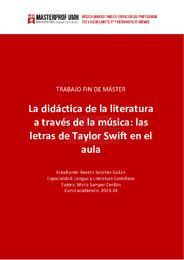Por favor, use este identificador para citar o enlazar este ítem:
https://hdl.handle.net/11000/32919Registro completo de metadatos
| Campo DC | Valor | Lengua/Idioma |
|---|---|---|
| dc.contributor.advisor | Samper Cerdán, María | - |
| dc.contributor.author | Sánchez Galián, Beatriz | - |
| dc.contributor.other | Departamentos de la UMH::Ciencias Sociales y Humanas | es_ES |
| dc.date.accessioned | 2024-09-04T10:53:56Z | - |
| dc.date.available | 2024-09-04T10:53:56Z | - |
| dc.date.created | 2024 | - |
| dc.identifier.uri | https://hdl.handle.net/11000/32919 | - |
| dc.description | Especialidad: Lengua y Literatura Castellana | es_ES |
| dc.description.abstract | Aprender sobre literatura puede ser algo en lo que los jóvenes desde hace unos años atrás no estén muy interesados (Glázquez, 2022). Sin embargo, es sabido que escuchar música es parte del ocio diario para muchos de ellos (Fernández, 2019). Por esto, con este trabajo se pretende alentar a las nuevas generaciones a aprender literatura de una manera más divertida y llevadera para ellos, esto es, a través de la música. Muchos compositores referencian en sus piezas musicales obras literarias anteriores, como recurso que les ayuda en la creación de símbolos y metáforas dentro de sus canciones, y como ayuda en su expresión de sus sentimientos y pensamientos. Por esto, en la actualidad, algunos docentes de literatura utilizan este fenómeno como recurso pedagógico con sus estudiantes, enseñándoles literatura a través de la muestra de estas canciones. Como ejemplo de esto, en este estudio, se analizarán aquellas canciones donde la cantautora estadounidense Taylor Swift hace referencia a obras literarias y autores, desde Shakespeare a Dickens, explicando el significado de estas letras y el motivo por el que se relacionan con las diferentes obras literarias. | es_ES |
| dc.description.abstract | Learning about literature may not be something that young people today are very interested in (Alonso, 2005). However, it is well known that listening to music is part of the daily leisure time for many of them (Fernández, 2019). For this reason, the aim of this work is to encourage the new generations to learn about literature in a more entertaining and bearable way for them, that is, through music. Many composers reference previous literary works in their musical pieces, as a resource that helps them in the creation of symbols and metaphors within their songs, and as an aid in their expression of their feelings and thoughts. For this reason, nowadays, some literature teachers use this phenomenon as a pedagogical resource to use with their students, teaching them literature through the sampling of these songs. As an example of this, in this study, those songs where the American singer-songwriter Taylor Swift makes reference to literary works and authors, from Shakespeare to Dickens will be analized, explaining the meaning of these lyrics and why in each case she has related them to the different literary works. | es_ES |
| dc.format | application/pdf | es_ES |
| dc.format.extent | 22 | es_ES |
| dc.language.iso | spa | es_ES |
| dc.publisher | Universidad Miguel Hernández de Elche | es_ES |
| dc.rights | info:eu-repo/semantics/openAccess | es_ES |
| dc.rights | Attribution-NonCommercial-NoDerivatives 4.0 Internacional | * |
| dc.rights.uri | http://creativecommons.org/licenses/by-nc-nd/4.0/ | * |
| dc.subject | Taylor Swift | es_ES |
| dc.title | La didáctica de la literatura a través de la música: las letras de Taylor Swift en el aula | es_ES |
| dc.type | info:eu-repo/semantics/masterThesis | es_ES |

Ver/Abrir:
TFM SANCHEZ GALIAN, BEATRIZ.pdf
1,53 MB
Adobe PDF
Compartir:
 La licencia se describe como: Atribución-NonComercial-NoDerivada 4.0 Internacional.
La licencia se describe como: Atribución-NonComercial-NoDerivada 4.0 Internacional.
.png)